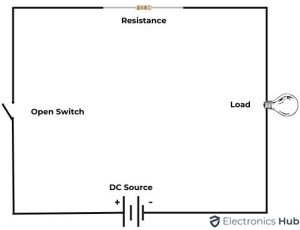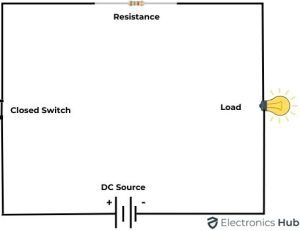An electric circuit is a path or a loop made of electrical wires and a power source that maintains a path for electron flow to generate electricity. An electronic appliance needs an electric circuit to function. From the regular lights inside your home to the washer, refrigerator, and even the most significant machines, all need electric circuits.
There are two types of circuits- Open circuit and closed circuit. Both are used, and both have different purposes and work principles. While it may seem that turning on or pressing a switch can initiate the electricity flow through the circuit, it may not be that simple. To know how things work, you need to understand both closed and open electrical circuits. Here is a simple article offering meaningful details on this matter!
Outline
ToggleWhat is an Electrical Circuit?
An electrical circuit is a path of inductors, capacitors, diodes, transistors, two terminals, resistors, and a continuous power source with continuous current flow through the complete loop.
Since there is a voltage difference between the source and the load, it initiates the electrons to flow from one end to another, initiating the current flow.
What is an Open Circuit?

In an open circuit, the current flow is zero but has a specific voltage. Since the current is zero, the power of the open circuit is also equal to zero. Hence, in an open circuit, the power dissipated.
Working in an Open Circuit
First, consider a simple example of an open circuit. A simple LED (Light emitting diode) light connected to a DC power source with an on-off switch and a resistor is an ideal example of an open circuit.
As the switch is “open”, the path is interrupted, and no active electricity flows through the path. Hence, the LED light remains off.
When the switch is in the closed position, it connects the broken path, and electricity starts to flow normally through the path, which turns on the LED light,
The operation of buzzer alarms also happens due to a similar mechanism. The Buzzer remains off because of the open circuit. When the switch is pressed, the tooth circuit completes, and electricity flows through the loop, which makes the buzzer ring.
What is a Closed Circuit?

In the case of a closed circuit, it always remains in an on position. Interestingly, a closed circuit does not need resistors or capacitors, as the current faces no obstacles.
In closed circuits, the open pathway creates a continuous channel for the flow of electrons and electricity. Hence, there is voltage between the terminal and the load. Closed circuits are more reliable and stable because they do not have breaks in their loop. They are widely used in most electronic appliances. For example, your refrigerator, air conditioning units, and electric motors inside cars and aeroplanes have closed circuits.
Working on a Closed Circuit
Let’s consider the TV that you use inside your home. It has a closed circuit, and continuous electricity flow ensures the TV ruins are without issues. The path is broken when the switch is turned off, and the TV loses its connection to the power supply.
Difference Between Open Circuit and Closed Circuit
There are some fundamental differences between the open and closed circuits:
- In the case of the open circuit, the path is “Open” or broken. Hence, it does not initiate the flow of current. On the contrary, the closed circuit is a complete pathway between the load and the source, and a continuous flow of current is present here.
- While an open circuit has no continuity, a closed circuit has continuity.
- An open circuit does not transfer electrical energy as it does not transfer the electrons from the power source to the load. On the contrary, the closed circuit transfers the energy as there is a continuous flow of energy from the power source to the load.
- In the case of an open circuit, the current flowing through it is zero. But, for closed circuits, the current flowing is infinite.
- For an open circuit, the voltage is zero. In contrast, a closed circuit has infinite voltage as it has a continuous current flow.
- If you check out the resistance, the open circuit ideally has infinite resistance. Still, it has very high resistance, as its voltage is zero. But for the closed circuit, the resistance is nearly zero.
- Compared to an open circuit, a closed circuit is more stable.
- The potential difference between the breaking points of the circuit is equal to the circuit’s supply voltage. On the contrary, the potential difference between the two terminals of the closed circuit is nearly zero.
| Factors | Open Circuit | Closed Circuit |
| Basic Definition | An open circuit is an electrical circuit with a broken path between the power source and the load, preventing the continuous flow of current. | A closed circuit is an electronic circuit that has a continuous loop between the power source and the load, which initiates a continuous power supply through the loop |
| Continuity | In an open circuit, continuity does not exist | Continuity exists in closed circuits |
| Energy Transfer | There is no energy transfer. There is not an active flow of electrons | Energy transfer happens as the electrons flow through the loop continuously |
| Symbol | ( ) | ( . ) |
| Current | In an open circuit, the current is zero as no active current flow is in its normal state. | In the closed circuit, current flow exists in infinite volume as there is a continuous flow of electricity. |
| Potential Difference | The potential voltage across the breaking point(s) is(are) Equal to the supply of voltage | The potential difference is nearly zero |
| Voltage | Voltage is zero | Voltage is infinite |
| Resistance | Ideally, infinite resistance, but in reality, the resistance is very high | Resistance is nearly zero |
| Stability | Less stable | More stable |
Conclusion
An open circuit is an electrical loop that comes with multiple breaks between the power source and the load, which prevents the continuous flow of electricity. On the other hand, the closed circuit is a continuous electrical path between the power source and the load with a continuous flow of electrons and electricity. An Open circuit can become a closed circuit when you close those breaks inside the circuit. A closed circuit is more stable than an open circuit and is reliable.
Open Vs Closed Circuit – FAQs
Ans: When the closed circuit is turned off, the path between the power source and the load breaks, which prevents the continuous flow of current. Hence, it transforms into an open circuit.
Ans: Multiple interconnected closed circuits create a complex electronic system used for more complex appliances. Each circuit can operate independently but needs to be interconnected to get power from the sources.
Ans: For a series circuit, the components are connected in a linear path, and if the circuit does not have any interruptions, it is a functioning closed circuit. But, in this case, a break between the power source and the load can transform it into an open circuit. But, in the case of a series circuit, multiple circuits are arranged in a parallel position. Hence, the other branch circuits can operate even if one open circuit exists.
Ans: Open circuits consume more energy as the open path results in continuous discharge. Hence, the battery drains faster, leading to diminished battery life.
Ans: Even though the closed circuits are designed to handle the load of a particular volume of current, these can get overloaded in case the devices consume more current than the permitted limit. Overloading often causes overheating, trooping of the circuit breakers, or even damage to the load, source, or other components of the circuit.

